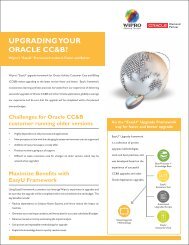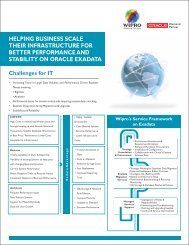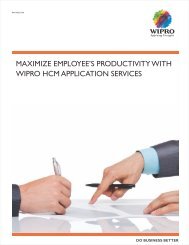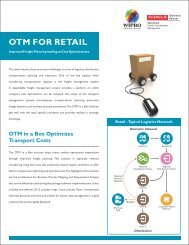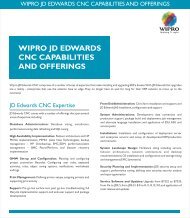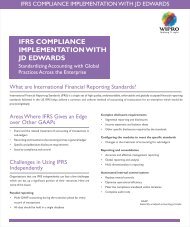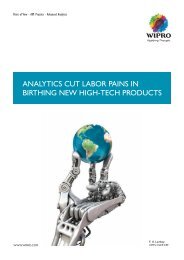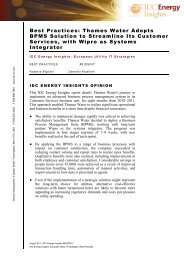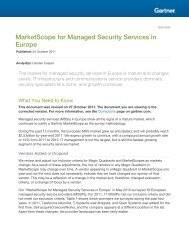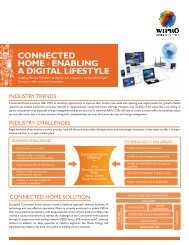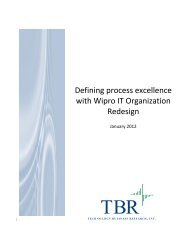Casestudy dofasco MES Implementation
Casestudy dofasco MES Implementation
Casestudy dofasco MES Implementation
Create successful ePaper yourself
Turn your PDF publications into a flip-book with our unique Google optimized e-Paper software.
CASE STUDY<br />
System Integration in an Integrated Steel Plant<br />
Centralizing procurement: Providing consulting, systems integration and<br />
program management services for world’s largest brown fi eld Manufacturing<br />
Execution System (<strong>MES</strong>) implementation in the steel sector which would enable<br />
the client streamline the business processes through ERP implementation<br />
in future and adapt change in doing the business from Make to Order (MTO) to<br />
Make to Inventory (MTI)<br />
The Idea: Executive Summary<br />
The organisation had a vision to replace its business layer applications through<br />
SAP implementation way back in 2005 – 2006. A large initiative was taken to<br />
achieve this fi t. They had started the implementation with SAP APO and had<br />
the intension to implement Financial, Procurement, and Commercial business<br />
processes and technology through Staged implementation with initial focus on<br />
“building the foundation”. But later realized that the processes and data in the<br />
layer (<strong>MES</strong>) below are not consistent leading into signifi cant effort and risk of integrating<br />
SAP solution to legacy <strong>MES</strong>. Therefore a new initiative was initiated to<br />
streamline the systems below the business layer applications in the Manufacturing<br />
Execution System space called <strong>MES</strong> Invision that will enable more structured<br />
process implementation and smooth data fl ow in the area of Demand Management,<br />
Order Processing, Planning and Scheduling, through Manufacturing to Shipping<br />
and Invoicing. This initiative will result into reduction in Production Costs,<br />
Inventories and Working Capital Requirements, Manpower and improvement in<br />
Quality, Service and Revenue on recurring basis every year.<br />
(Contd on next page)
CLIENT<br />
Our client is world’s largest Steel Maker. This<br />
particular <strong>MES</strong> implementation is for one its<br />
largest Integrated Steel Making Unit in Canada, a<br />
very advanced fl at product complex.<br />
BUSINESS CHALLENGES : BEFORE<br />
Business Situation<br />
Developments in global steel markets had placed<br />
additional demands on the business and<br />
manufacturing execution processes (<strong>MES</strong>).<br />
These developments include:<br />
• Stiff competition and a need to ensure lowest<br />
cost operations<br />
• Operating at lower Working Capital associated<br />
with steel inventory<br />
• Higher demands for better customer service<br />
and quality by customers<br />
• Increase in capacity demands more<br />
streamlined processes<br />
• Mode of business largely changed from Make<br />
to Order (MTO) to Make to Inventory (MTI)<br />
Business Case<br />
The way business happens in the steel sector<br />
has changed substantially over years. First, prior<br />
to 80’s it was monopoly market and the market<br />
was quite localized. In 90’s however the steel<br />
customers had more choices in the market as<br />
the market opened up and thereby steel makers<br />
were subjected to fi erce competition to garb the<br />
market share. So far steel customers used to buy<br />
steel at favorable price when it was available and<br />
use it when it was required. But this had resulted<br />
in carrying forward unwanted inventory and loss<br />
and degradation of inventory due to weathering<br />
effect. Steel market therefore again changed.<br />
Concept of JIT came in and forced the steel<br />
makers to carry the unfi nished inventory at their<br />
end instead, to be supplied to their customers at<br />
a short notice.<br />
Over years the organisation had developed a fully<br />
automated Business and <strong>MES</strong> system to cope up<br />
with this changing market scenario. While the<br />
legacy world was equipped to address the MTO<br />
scenario, it required a new set of applications<br />
to address the MTI scenario. Therefore a set of<br />
new applications were built using various client<br />
server platforms. Both set of systems had to coexist<br />
to comply with the ever changing market<br />
demand. This however required high volume of<br />
data bridging between the two worlds. Eventually<br />
this had resulted in maintaining very large number<br />
of applications in the business and <strong>MES</strong> layers in<br />
multiple technology platforms and incur large<br />
amount of processing delays. The organisation<br />
had faced major challenges in recent times to<br />
cope up with the dynamic market condition due<br />
to such system defi ciency.<br />
In the year 2006 the organisation had taken up<br />
the initiative to modernize its business layer<br />
applications by replacing the existing legacy<br />
systems with SAP. It was soon realized however,<br />
that the lower order systems, especially the<br />
Manufacturing Execution Systems (<strong>MES</strong>), were not<br />
in a state to have this transition seamlessly, owing<br />
primarily to the lack of defi nition, identifi cation<br />
(Contd on next page)
and sourcing of data elements from the existing<br />
systems.<br />
A new initiative was thus undertaken to implement<br />
a COTS package for <strong>MES</strong>. This package, is an SAP<br />
compliant product and has advanced features to<br />
optimize the operation. This package will replace<br />
the fi nishing <strong>MES</strong> of the organisation.<br />
The implementation of this package requires<br />
widespread integration and enhancements of<br />
the existing applications at different levels of<br />
enterprise automation – including business area for<br />
Demand Management, Sales Order Management,<br />
Product Confi guration, Planning, Scheduling,<br />
Production Execution, Product Inventory, Lab<br />
and Quality, Shipping, Invoicing and Level 2<br />
Automation systems.<br />
WIPRO SOLUTION:<br />
HOW WIPRO HELPED<br />
Solution Scope<br />
Wipro was engaged as its primary system integrator<br />
for this implementation. The system integration<br />
solution scope includes remediation, integration,<br />
data-warehousing & reporting, end-to-end<br />
testing and comprehensive program management<br />
including Business Change Management.<br />
Proposed Solution<br />
• Integrate all applications of dissimilar<br />
technologies through implementation of<br />
a loosely coupled enterprise integration<br />
framework<br />
• Remediate all impacted applications<br />
• Redesign Data models, migrate data, modify<br />
Data warehouse, build new reports<br />
• Do comprehensive end to end testing<br />
• Manage complete program that involves<br />
multiple vendors<br />
• Provide Business Change Management support<br />
• Help customer to achieve business benefi t as<br />
envisaged<br />
Replacement of Manufacturing Execution System<br />
applications by <strong>MES</strong> package solution (Advance<br />
Line Sequencing & Production Execution System<br />
modules) is fi rst step towards SAP implementation<br />
in future. This requires integration of the<br />
new package with existing applications and<br />
decommissioning of the redundant applications.<br />
Scope of impact analysis spreads over 145<br />
applications in a cluster of 284 applications. Out<br />
of these 145 applications 82 of them requires<br />
remediation (major enhancement) and 33 of them<br />
needs to be decommissioned.<br />
The enterprise integration framework provides the<br />
basic infrastructure for fl ow of data in the form<br />
of messages between source and target systems.<br />
(Contd on next page)
This integration framework is highly scalable,<br />
confi gurable (meta-data driven) and fl exible.<br />
Message, fl ow, route, endpoint, fi lter and task<br />
details are stored in the Meta-Data Repository,<br />
enabling maximum reuse by all components and<br />
non-intrusive implementation. Flow specifi c<br />
properties for endpoint, tasks and fi lters are<br />
parameterized and hence easily confi gurable. It<br />
transforms data from one structure to another as<br />
per requirement and supports generic components<br />
like Exception Handling, Auditing and Logging,<br />
etc.<br />
For further information, please contact: Wipro Technologies<br />
Visit us at<br />
www.wipro.com<br />
Copyright © 2010 Wipro Technologies<br />
All rights reserved.<br />
All trademarks mentioned herein<br />
belong to their respective owners.<br />
BUSINESS RESULTS : Expected by 2010<br />
• Production Costs<br />
–Reduction in Delays , IT Support cost, Reduction<br />
in value destroying (business) rules, Outside<br />
Processing Yield Performance Monitoring and<br />
Improvement<br />
• Inventories and Working Capital Requirements<br />
–Inventory (reduction in total Hot Band and<br />
WIP)<br />
• Quality and Service<br />
–Reduction in use of scheduled warmers, Yield<br />
& Claims improvement, Reduction in Reapplies,<br />
Rework, Scrap and improved Data integrity<br />
• Manpower<br />
–Reduction in Customer Service, Manufacturing<br />
Technology, IT workforce<br />
• Revenue Improvement<br />
–Improvement in re-allocation to prime




